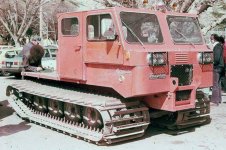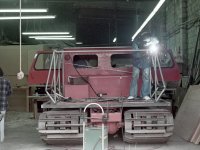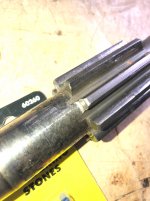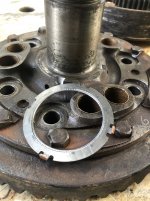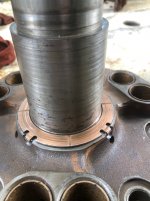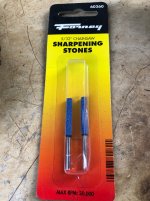-
Please be sure to read the rules and adhere to them. Some banned members have complained that they are not spammers. But they spammed us. Some even tried to redirect our members to other forums. Duh. Be smart. Read the rules and adhere to them and we will all get along just fine. Cheers. :beer: Link to the rules: https://www.forumsforums.com/threads/forum-rules-info.2974/
You are using an out of date browser. It may not display this or other websites correctly.
You should upgrade or use an alternative browser.
You should upgrade or use an alternative browser.
Help with Snowcat indentification
- Thread starter Titon
- Start date
Thiokol of sorts. The experts will chime in but look Spryte ish.
The older A models had a OC 4 trans axle. The b's and later I believe had the OC 12 rear, and a bigger engine than the A's.
that Spryte is a popular old machine.
I bet some one here will know way more that I. A pic of the rear diff would help out al lot...
that Spryte is a popular old machine.
I bet some one here will know way more that I. A pic of the rear diff would help out al lot...
I think it's a Thiokol Spryte 1200C, standard width track; which would get you the OC-12 rear, a Ford 300 I-6 and C6 transmission. The wheels are aluminum castings that use (no longer available) Goodyear "Monorail tires". The grousers are different as well.
It looks to me like the slightly wider upper cab came from the factory that way.
However, I am not very knowledgeable about the Thiokol/DMC/LMC lineup. "Marginally educated" is a fair description.
It looks to me like the slightly wider upper cab came from the factory that way.
However, I am not very knowledgeable about the Thiokol/DMC/LMC lineup. "Marginally educated" is a fair description.
I have to wonder if it might be factory, or just modified. Can you tell up close?Thanks for the replies guys!
The upper cab indent is what's throwing me off. Every 1200 i find pictures of doesn't have that indent.
Spryte cabs would benefit from some additional elbow room. The dog house limits room for many in the front seats.
Definitely an OC 12 rear under the rear FYI
Cool rig for sure.
My snowcat buddy, Scott has a 1976 Thiokol 1200C and the emblem arrangement is similar to that on this machine. "Spryte" below the front doors and "Thiokol" below the right side (or passenger side, if you prefer) headlights. With no photos of the interior of this machine, I can't offer anything...
One thing that looks odd to me, and I hope others will opine on this as well, is the configuration of the OC-12 rear differential assembly. When used on Super Imps and DMC 1450s, the axle housings bolt directly to the center differential assembly. This has the effect of raising the rear drive sprocket somewhat and the tracks angle up toward the back accordingly. Sprytes and 1200s use drop boxes between the center differential assembly and the axle housings. This machine does not have the drop boxes. Look at photos of the sides of Sprytes and 1200s. You'll see the top of the track is flat from front to back. Now look at this machine and you'll see the track angles up in the rear. Also note the second photo of this machine. Where are the drop boxes?
Here are pics of Scott's 1200C (aka: "Porky"). Note how the top of the track is flat.

A rear view. Note the drop boxes.

The drop boxes are geared in either (I think) 1.83:1 or 2.44:1 so they lower the ratio of the rear axle and this makes the required steering effort a bit easier. They also have the effect of raising the rear differential which adds ground clearance; another good thing.
Piggy-backing on 300 H and H's comments, another nice to have feature are taller front doors. For most of the Spryte/1200 production years the front doors are somewhat short and you "climb in".
I can't tell you when the production change was made, but if you look at photos of LMC 1200s the doors are taller, making ingress and egress easier. I've seen photos of DMC 1200s with the short style doors, so I think the change was made after Thiokol was sold to Delorean, and perhaps not until it was sold again and became LMC (1984-ish).
One thing that looks odd to me, and I hope others will opine on this as well, is the configuration of the OC-12 rear differential assembly. When used on Super Imps and DMC 1450s, the axle housings bolt directly to the center differential assembly. This has the effect of raising the rear drive sprocket somewhat and the tracks angle up toward the back accordingly. Sprytes and 1200s use drop boxes between the center differential assembly and the axle housings. This machine does not have the drop boxes. Look at photos of the sides of Sprytes and 1200s. You'll see the top of the track is flat from front to back. Now look at this machine and you'll see the track angles up in the rear. Also note the second photo of this machine. Where are the drop boxes?
Here are pics of Scott's 1200C (aka: "Porky"). Note how the top of the track is flat.
A rear view. Note the drop boxes.
The drop boxes are geared in either (I think) 1.83:1 or 2.44:1 so they lower the ratio of the rear axle and this makes the required steering effort a bit easier. They also have the effect of raising the rear differential which adds ground clearance; another good thing.
Piggy-backing on 300 H and H's comments, another nice to have feature are taller front doors. For most of the Spryte/1200 production years the front doors are somewhat short and you "climb in".
I can't tell you when the production change was made, but if you look at photos of LMC 1200s the doors are taller, making ingress and egress easier. I've seen photos of DMC 1200s with the short style doors, so I think the change was made after Thiokol was sold to Delorean, and perhaps not until it was sold again and became LMC (1984-ish).
Alaska Snow Cat
Member
It's a Spryte 1202 and most likely a C model, The tracks are definitely from a C model or the newer DMC or LMC 1200s. The wide cab was a factory option and I have seen a few over the years. My buddy had one. His was a 76 but did not have the drop axels like most OC-12 have. It was originally purchased by the state of Alaska and had the rear end disassembled when my buddy bought it at auction. He had the rear end rebuilt by a reputable machine shop that specialized in Nodwells, Bombardiers and Thiokols. The rear end grenaded after only a few hours. Not sure what the problem was or if it was even an OC-12 but it was factory.
Good info here...It's a Spryte 1202 and most likely a C model, The tracks are definitely from a C model or the newer DMC or LMC 1200s. The wide cab was a factory option and I have seen a few over the years. My buddy had one. His was a 76 but did not have the drop axels like most OC-12 have. It was originally purchased by the state of Alaska and had the rear end disassembled when my buddy bought it at auction. He had the rear end rebuilt by a reputable machine shop that specialized in Nodwells, Bombardiers and Thiokols. The rear end grenaded after only a few hours. Not sure what the problem was or if it was even an OC-12 but it was factory.
If there are no drop boxes and no final reduction before the tracks, the top speed would be substantially higher.
But there is no free lunch here, as the mechanical stress is no longer being taken up by the reduction in the drop boxes.
Lack of the drop boxes would increase stress to the main diff proportional to the gear ratio of the reduction...
Could it be that those machines with out drop boxes were prone to failure, with drawn from the market because of this?
Could that explain why this straight axle set up on a Spryte is not widely known?
Kirk,Good info here...
If there are no drop boxes and no final reduction before the tracks, the top speed would be substantially higher.
But there is no free lunch here, as the mechanical stress is no longer being taken up by the reduction in the drop boxes.
Lack of the drop boxes would increase stress to the main diff proportional to the gear ratio of the reduction...
Could it be that those machines with out drop boxes were prone to failure, with drawn from the market because of this?
Could that explain why this straight axle set up on a Spryte is not widely known?
I think THE expert on the OC-12’s is Pat Foster, AKA: Snowcat Pat on the forum. I would absolutely defer to him and his knowledge and expertise...
I do know that in addition to the different drop box gear ratios, there were also different ring and pinion gear ratios used in the center differential assembly. I believe 4.47:1 was commonly used by Thiokol/DMC/LMC and with a 2.44:1 drop box that would yield a combined 10.91:1 ratio. With a 1.83:1 drop box ratio the combination would be 8.18:1. I have a DMC 1450 and that of course has no drop boxes. However, Thiokol/DMC (LMC discontinued the 1450 model) compensated for that by using lower ring and pinion gear ratios in the center differential.
I have a copy of the order sheet for my DMC 1450 and it shows a ring and pinion ratio of 7.38:1. Roughly 10% higher than the 4.47:1 and 1.83:1 combination I mentioned above.
Snowy Rivers
Well-known member
The common R&P ratios were 5.44 (Scarce today) and 6.14
As has been stated.....The drop boxes could be had in 1.83 and 2.44
At this late date whatever is in the rear end is likely the result of what ever parts could be scrounged up when parts were needed.
The OC12 is a stout gear box and should be able to stand up to just about anything that the Spryte with the 6 cyl engine will toss at it.
The larger machines like the 2100 packmaster with the 57" tracks ...OR MORE and the V8 up front reefing on things really changed the course of how life went in the gear box.
Many times the loss of the rear ends WAS NOT due to the parts being too small/weak BUT INSTEAD to failure of thrust washers and a few other small parts that would shed pieces that found their way through the ring and pinion and also into the many bearings.
Once the bearings started breaking up the destruction increases mega times and the end comes soon after.
The compensator gears have steel thrust washers that are about 2" in diameter and the gears chew on these and shed metal particles.
The inner compensator gears have thin shim like thrust washers that also chew up and add to the mess circulating in the oil....
Deburring the compensator (Small outer) gears on each end helps stop a lot of the "chewing" on the washers.
There are two thrust washers ...one between each inner gear on the drums that are also a thin shim like piece..
These wear out and go away.
On my 2100 I machined1 the case and replaced the thin shim like washers with some very robust time proven thrust washers from automotive type transmissions .....
Drum to Carrier case thrust washer (Use Chevy TH400 rear thrust washer 4 tang type)..Machine case halves to accept 2 tangs.... Machine washer on back side so washer fits around radius on journal and lays flat against shoulder... (Make 2)
****Some tweaking**** of the tangs required to have the washer sit snug in its position on the carrier ****
Inner axle gear/s Thrust washer at center compensator housing (Use Ford A4LD Front drum to direct drum thrust washer).... Ford part number 84GT7D428AA (2 required) machine both sides of the inner case)
These mods will go a long way to curb the amount of crap being chewed up.
Another big issue is WATER
Water gets into the box.....causes rust in the bearings...Over time the bearing surfaces degrade and then "Shellout" occurs and the bearings really start to go away.....
The final phase of the bearing failure will see rollers/balls actually break up and large pieces get thrown into the oil pool.
These are HARD CHUNKS
Once they find the ring and pinion gears......GAME OVER....Teeth break and the box grenades.
The internal mods, bearings kept in good shape and the oil kept clean and free of water.
Anything in the way of metal coming out in the oil on a drain out should be taken seriously...very seriously.
There are normal wear items in these boxes.....BANDS AND THE DRUMS.....But this is very tiny amounts of metal.....FINE STUFF.
Always have a magnetic plug in the diffy and the drop boxes.
The gears in the drop boxes are huge and very tough.....They can chew up stuff readily but then it goes to work destroying the bearings.
Clean oil and inspections are key to keeping these bad boys doing their job.
The OC12 is heavy and pretty herky...but not that hard to get apart and repair.
The repair manual is available in data form here at the forum
The task looks daunting......NOT REALLY....just a job that requires keeping all parts in the order they came out.....
The machining of the inner parts to accept the thrust washers is a simple task that can be done by any machine shop with a mill and a lathe.
Simple math to calculate the differences between the original thrust washers and what is going back....= how much to machine off.
The steel backed bronze washers were designed with lube indents and a surface that can take some serious use...
KEEP IN MIND
The ring and pinion in the OC12 are large.....the parts used in the 1 ton 4x4 trucks that get the hell beat of them are not as big and they usually last pretty good.
The issues with the OC12 are due to FOREIGN MATERIAL (Junk chewed up in the box) and destruction from water that normally claim the parts and end the service life.....
****** NOTE*****
These nice little stones in a die grinder will work sweet to debur the gear teeth.
Notice the sharp edges on the small planet gear teeth....ROUND THE EDGES JUST ENOUGH TO STOP THE TEETH FROM CHEWING LIKE A CUTTING TOOL......Then the oil will generally keep the thrust washers in good shape
Good luck.
As has been stated.....The drop boxes could be had in 1.83 and 2.44
At this late date whatever is in the rear end is likely the result of what ever parts could be scrounged up when parts were needed.
The OC12 is a stout gear box and should be able to stand up to just about anything that the Spryte with the 6 cyl engine will toss at it.
The larger machines like the 2100 packmaster with the 57" tracks ...OR MORE and the V8 up front reefing on things really changed the course of how life went in the gear box.
Many times the loss of the rear ends WAS NOT due to the parts being too small/weak BUT INSTEAD to failure of thrust washers and a few other small parts that would shed pieces that found their way through the ring and pinion and also into the many bearings.
Once the bearings started breaking up the destruction increases mega times and the end comes soon after.
The compensator gears have steel thrust washers that are about 2" in diameter and the gears chew on these and shed metal particles.
The inner compensator gears have thin shim like thrust washers that also chew up and add to the mess circulating in the oil....
Deburring the compensator (Small outer) gears on each end helps stop a lot of the "chewing" on the washers.
There are two thrust washers ...one between each inner gear on the drums that are also a thin shim like piece..
These wear out and go away.
On my 2100 I machined1 the case and replaced the thin shim like washers with some very robust time proven thrust washers from automotive type transmissions .....
OC12 Thrust washer mods.
Drum to Carrier case thrust washer (Use Chevy TH400 rear thrust washer 4 tang type)..Machine case halves to accept 2 tangs.... Machine washer on back side so washer fits around radius on journal and lays flat against shoulder... (Make 2)
****Some tweaking**** of the tangs required to have the washer sit snug in its position on the carrier ****
Inner axle gear/s Thrust washer at center compensator housing (Use Ford A4LD Front drum to direct drum thrust washer).... Ford part number 84GT7D428AA (2 required) machine both sides of the inner case)
These mods will go a long way to curb the amount of crap being chewed up.
Another big issue is WATER
Water gets into the box.....causes rust in the bearings...Over time the bearing surfaces degrade and then "Shellout" occurs and the bearings really start to go away.....
The final phase of the bearing failure will see rollers/balls actually break up and large pieces get thrown into the oil pool.
These are HARD CHUNKS
Once they find the ring and pinion gears......GAME OVER....Teeth break and the box grenades.
The internal mods, bearings kept in good shape and the oil kept clean and free of water.
Anything in the way of metal coming out in the oil on a drain out should be taken seriously...very seriously.
There are normal wear items in these boxes.....BANDS AND THE DRUMS.....But this is very tiny amounts of metal.....FINE STUFF.
Always have a magnetic plug in the diffy and the drop boxes.
The gears in the drop boxes are huge and very tough.....They can chew up stuff readily but then it goes to work destroying the bearings.
Clean oil and inspections are key to keeping these bad boys doing their job.
The OC12 is heavy and pretty herky...but not that hard to get apart and repair.
The repair manual is available in data form here at the forum
The task looks daunting......NOT REALLY....just a job that requires keeping all parts in the order they came out.....
The machining of the inner parts to accept the thrust washers is a simple task that can be done by any machine shop with a mill and a lathe.
Simple math to calculate the differences between the original thrust washers and what is going back....= how much to machine off.
The steel backed bronze washers were designed with lube indents and a surface that can take some serious use...
KEEP IN MIND
The ring and pinion in the OC12 are large.....the parts used in the 1 ton 4x4 trucks that get the hell beat of them are not as big and they usually last pretty good.
The issues with the OC12 are due to FOREIGN MATERIAL (Junk chewed up in the box) and destruction from water that normally claim the parts and end the service life.....
****** NOTE*****
These nice little stones in a die grinder will work sweet to debur the gear teeth.
Notice the sharp edges on the small planet gear teeth....ROUND THE EDGES JUST ENOUGH TO STOP THE TEETH FROM CHEWING LIKE A CUTTING TOOL......Then the oil will generally keep the thrust washers in good shape
Good luck.
Attachments
Last edited:
Snowy Rivers
Well-known member
Not to be negative at all....But so many of these cats have seen a lot of mods over the decades since they were built.
Some are actually better than the factory had things to begin with...others not so much...
Unless you can get good info on your cat as to what may have been done.....things can be tough to sort out.
Did you find the original builders plate....this should be riveted to the sheet metal in the cab and have model # and such ?????
Some are actually better than the factory had things to begin with...others not so much...
Unless you can get good info on your cat as to what may have been done.....things can be tough to sort out.
Did you find the original builders plate....this should be riveted to the sheet metal in the cab and have model # and such ?????

